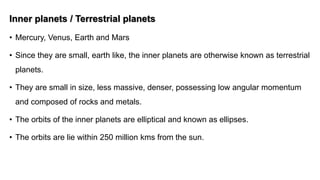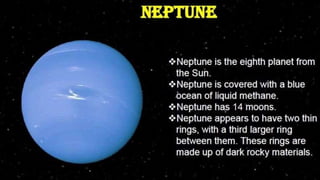Solar system
- 1. Solar system Nipin K P kp.nipin@gmail.com
- 2. Solar System The sun with its family of planets and their satellites, asteroids, comets, meteorites and all other objects revolving around it under the influence of its gravitational field, constitute the solar system. • A star is a luminous body. • A star with its planets and satellites form a star system. • A group of stars is called constellation. • A number of constellation form a galaxy. • Galaxy is the fundamental unit of the universe.
- 3. Asteroids are huge chunks of rocks and metals. Asteroids have different shapes and sizes. Most asteroids have a diameter of more than 200 km. The main asteroids • There are at least 100 billion stars in a galaxy. • The universe, which is the limitless space, contains at least one billion galaxies. • At present the universe is expanding. The galaxies, the individual units are moving away from one another at great speed. • The galaxy to which our solar system belongs is called the Milky way galaxy. It is a spiral shaped galaxy. (Other two types are elliptical and irregular) • Our galaxy travels around the galactic center at a speed of 240 km/sec and it takes about 200 million years to complete one revolution.
- 4. Structure of Milky way • Milky way galaxy is flat, disk shaped, with a central nuclear bulge. • The core of the galaxy consists of black holes and super massive stars. They are surrounded in turn by the smoke rings (-high temp. molecular gas cloud and star clusters). • Smoke rings are surrounded by gas nebulae , which marks the outer boundary of the central bulge of the galaxy. • Our sun is situated in one of the three spiral arms of the nebulae. • Nebulae are surrounded by a halo consisting of older stars, which in turn surrounded by corona having greater dimensions and very high mass.
- 5. Sun and the planets • Sun forms the centre of the solar system around which the other planets revolve is situated on the inner edge of the middle spiral arm, 8500 parsecs away from the galactic centre. (1 Parsec= 3.26 light years or 3.086×1013) • Solar system consists of 8 planets. These planets can be divided in to two groups (i) Inner planets / Terrestrial planets (ii) Outer planets / Jovian planets
- 7. Inner planets / Terrestrial planets • Mercury, Venus, Earth and Mars • Since they are small, earth like, the inner planets are otherwise known as terrestrial planets. • They are small in size, less massive, denser, possessing low angular momentum and composed of rocks and metals. • The orbits of the inner planets are elliptical and known as ellipses. • The orbits are lie within 250 million kms from the sun.
- 8. Outer planets / Jovian planets • Jupiter, Saturn, Uranus and Neptune are the outer planets. • These planets are very large, giant and are called the Jovian planets. • They are massive of low density, composed of mostly gases and possess vast atmospheres. • They have high angular momentum and may have small rocky or metallic cores. • Their orbits are circular and lie between 750 to 5900 million kms from the Sun.
- 17. Asteroids • Also called minor planets. • They are small, rocky objects that orbit the sun. • The inner planets and outer planets are separated from each other by a belt of minor planets called Asteroid belt. • Asteroids range in size from Ceres, which has a diameter of about 1000 km, down to the size of pebbles. • Composition of the asteroids is thought to vary from nickel-iron to silicate rock. • They follows circular orbit as same as outer planets.
- 18. Comets • Comets are the most spectacular and unpredictable bodies in the solar system. • They mostly made up of water, ice, dust and rocky-metallic materials. • They are spotted only when they move closer to the sun. In such an event, ice melts and forming a tail. • When comets comes nearer to the sun it loses a part of its mass, get separated and is showered on planets. • The loss of mass reduces the life of a comet gradually, till it is relieved of all its gas and ice. Thus its life is limited to a finite number of years.
- 19. Meteorites • A fragment of solid matter entering the earth’s atmosphere from outer space is called a meteoroid. They are very tiny particles. • A meteor is a thin trail of light, left after the vaporization of a meteoroid during its penetration in to the atmosphere. • The larger meteoroids reach the surface even if they are partially vaporized. Such solid objects from outer planetary space that has fallen to the earth’s surface are called meteorite. • The fall of a meteorite is accompanied by a brilliant flash of light, called a fireball, and loud sounds. Thus it is also referred to as shooting stars.
- 20. • The physical impact of the meteorites on the solid earth results in large-scale excavation and removal of crustal materials in a high temp. and pressure condition. • Craters are thus formed by meteoritic impact. A three classes of meteorites are recognized:- 1. Iron Meteorites- those composed of entirely metals (Ni, Fe) 2. Stony meteorites- those composed of dominantly of silicate materials. Two kinds - Chondrites and achondrites 3. Stony-iron meteorites.- those consisting of both metals and silicate materials; stony- iron
- 21. Some factors regarding solar system • Mercury and Earth have magnetic fields. • Venus has a core like earth, but it is not magnetic because its rotation is slow. • Mars has a core and rotates fast, but it is not magnetic probably due to the solid nature of the core. • The revolution period of Mercury is 88 days, which is the shortest period. • Jupiter is the largest planet. • Planets such as Saturn, Jupiter and Uranus have ring systems and ring system of Saturn is elaborate.





















